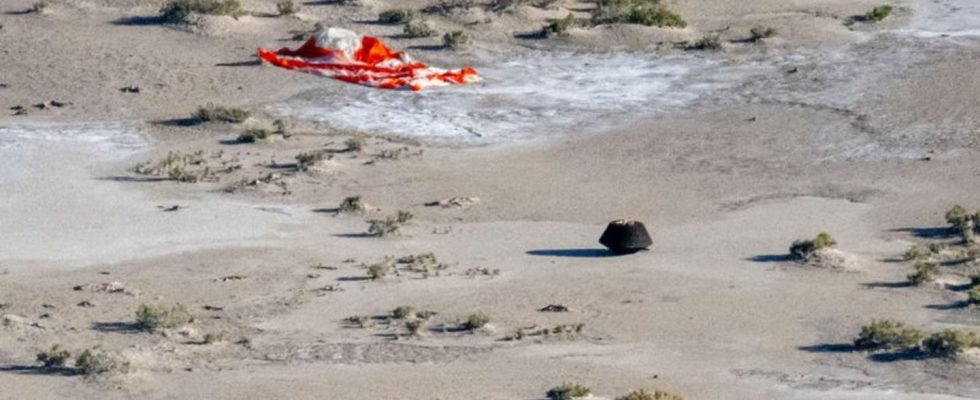NASA
Asteroid sample may be examined tomorrow
The capsule released by the Osiris-Rex spacecraft lies near the parachute after landing on Earth. photo
© Keegan Barber/NASA TV/AP/dpa
In a good 150 years, the asteroid Bennu could come quite close to Earth. That’s not the only reason NASA wants to research it in detail. What is planned now.
NASA scientists announced this at a press conference a few hours after landing on Sunday (local time). The probe had previously dropped the capsule with the sample at an altitude of around 102,000 kilometers above Earth. Protected by a heat shield and slowed down by parachutes, the capsule then landed in the desert of the US state of Utah. According to NASA, it remained undamaged as hoped.
She was taken by helicopter to a first sterile laboratory near the landing site and subjected to a “nitrogen purge”. This should prevent contamination. Today the sample could then be brought to NASA laboratories in the US state of Texas – where around 200 scientists will be working on the material using 60 different examination methods from Tuesday. NASA has announced a press conference for October 11th where the first results of the investigations will be announced. According to NASA estimates, the capsule contains around 250 grams of rubble that was collected from the celestial body around three years ago.
Sample taken could be historical
If the contents of the capsule turn out as NASA hopes, it would be the first sample of an asteroid successfully brought to Earth in the history of the US space agency – and probably the largest such sample ever taken. In 2005, the Japanese space probe “Hayabusa” landed on an asteroid. In 2010, it brought the first soil samples ever collected from such a celestial body to Earth. There have been other flights to asteroids, but no other probe has yet brought material back to Earth.
“Osiris Rex” (the abbreviation stands for: Origins, Spectral Interpretation, Resource Identification, Security-Regolith Explorer) was launched from the Cape Canaveral spaceport in September 2016 and arrived at Bennu around two years later. In October 2020, the probe took a sample from the asteroid in a complicated maneuver lasting several hours – the first US missile in space history.
Why NASA wants to research Bennu in detail
The deep black Bennu, named after an ancient Egyptian deity, has a diameter of around 550 meters and could come quite close to Earth in a good 150 years. Even if the risk of impact is very low, NASA counts Bennu as one of the most dangerous asteroids currently known – and therefore wants to research it in detail. The scientists also hope that the “Osiris Rex” mission, which costs around a billion dollars, will provide insights into the formation of the solar system more than 4.5 billion years ago, because such asteroids are remnants of it.
The “Osiris-Rex” probe, which is approximately six meters long and weighs 2,100 kilograms, set off for the next asteroid, Apophis, immediately after it was released. According to calculations, the asteroid with a diameter of around 370 meters will fly past Earth at a distance of around 32,000 kilometers in 2029 and could therefore be studied up close for the first time. The mission had already been extended by at least nine years – and now has a new name: “Osiris Apex”.

